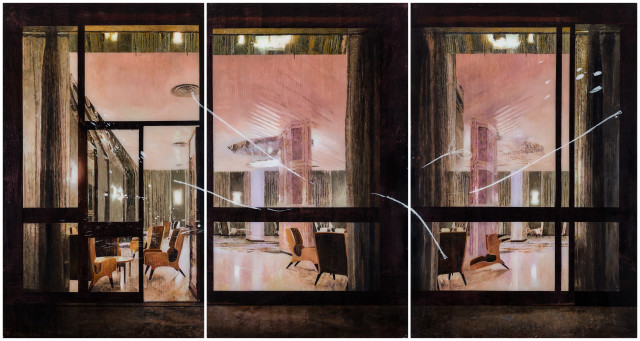Imagine you are on a threshold. But the spaces before and behind you are ambivalent.
Before: a ghostly shadow-world, where absence dwells in cavernous or cell-like spaces, rhythmed by the background hum of continual vertical lines. Behind: the viewing space, bounded by the gallery walls and floor. Or is it?
Gil Heitor Cortesão's paintings complicate your status as spectator. You become a voyeur, enmeshed in the narrative space of the painting by sheer proximity to it. Stepping up to the work means sinking further into its liminal depths. Cortesão denies you any distance. Here, you search for perspective in vain. You are untethered on this brink, neither inside nor outside, where public melts into private. Uneasiness abounds.
Umbra is Portuguese painter Cortesão's fourth solo show with Carbon 12. Shadows, as the Latin title suggests, are complex denizens of these works, both discursively and materially. In Cortesão's palette, shadow is a projection, beamed from some spectral world. A grey eeriness wafts through the forsaken interiors of the Passage series, as well as the cell-like confines of the Room works. Color, an occasional Cortesão obsession, has succumbed to a shadowy chill.
Tension brims in every frame. The stasis of the neat, geometrical space is disrupted by a painterly mark-the wavering smear of Passage #1, pillar-like drippings in Umbra #2, the exuberant splash in Circular Pool. Such corporal touches (for this is the painter's body weighing into the work), far from being some final expressionist flourish, are in fact the first marks made on the plexiglass surface. As Cortesão uses the "reverse glass" painting technique-painting on the opposite side of the transparent surface-the process is inverted. What would come last on a canvas comes first on the far side of the glass. Cortesão starts with the detail and paints the work "back" from there. From the outset, the mark is a deliberate antagonist to the rectitude of the frame-a violent eruption in the barrenness of order.
Another tension: the bodies of works are pitted against themselves. Passage #1, Passage #2 and Passage #3 are essentially landscapes in which some furtive movement rustles-in the smudges and drips of process, or the ambling action. Static and poised, the smaller works-Giorgio's Room, View with a Room and White Room-counter the sprawling landscapes with their box-like confinement. Umbra #1 and Umbra #2 are darker, spookier realms rendered in large scale, while Circular Pool sits, somewhat merrily, away from the others in tone and verve.
Across all the works, though, Cortesão manipulates inside and outside, the illusionary space of the painting and the real space grounding the viewer. As a spectator of Cortesão's world, you lurk: peering into the bright lights of a hollow function room from a somber terrace, loitering at an icy poolside, huddled in oaken shadows.
Modern architecture is a prized graphic device for the painter, its strict linearity and cubic modularity providing a rich ground for spatial play, for plumbing the limits of 2D/3D tension. Yet it also harks back to the rise of visual art in the hands of painters like Malevich and Mondrian-when art was almost subsumed into architecture, and paintings were redolent of the built space. Similarly, line pulses throughout Cortesão's paintings, creating an almost corrugated effect in the background. These streaks are the fruit of a process of doing-undoing-redoing, representing layers of paint that were applied and removed, seeping through the image with each destructive swipe. The result is an oddly unifying touch-an echo of a methodical rhythm amid the painterly din.
So here you stand: on the threshold, teetering towards virtuoso paintings, sprung from the shadows.
- Kevin Jones, February 2018

